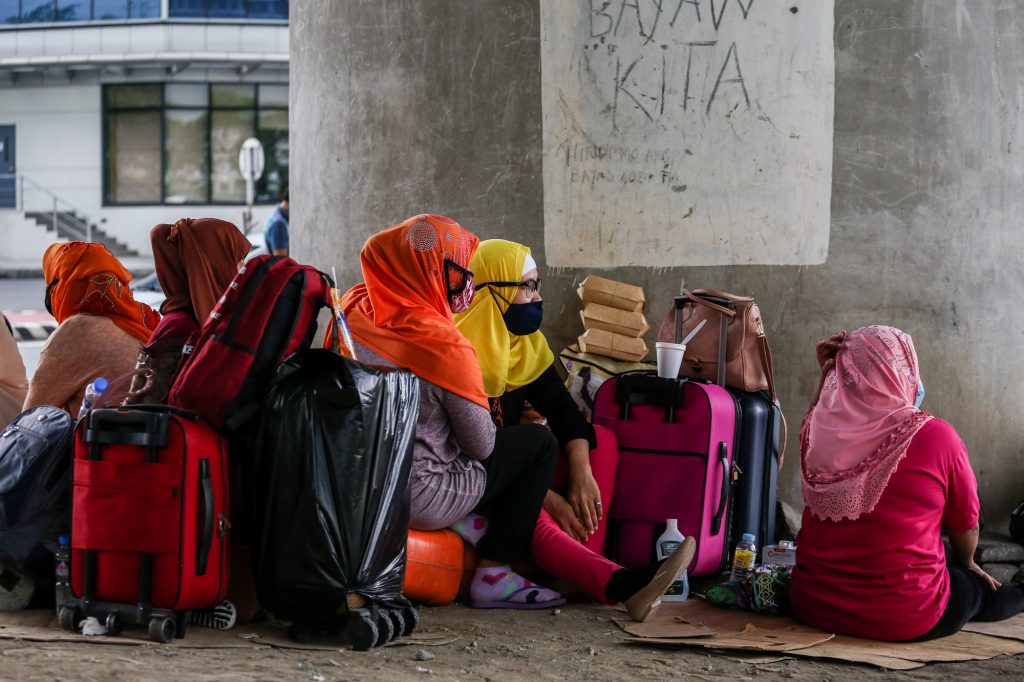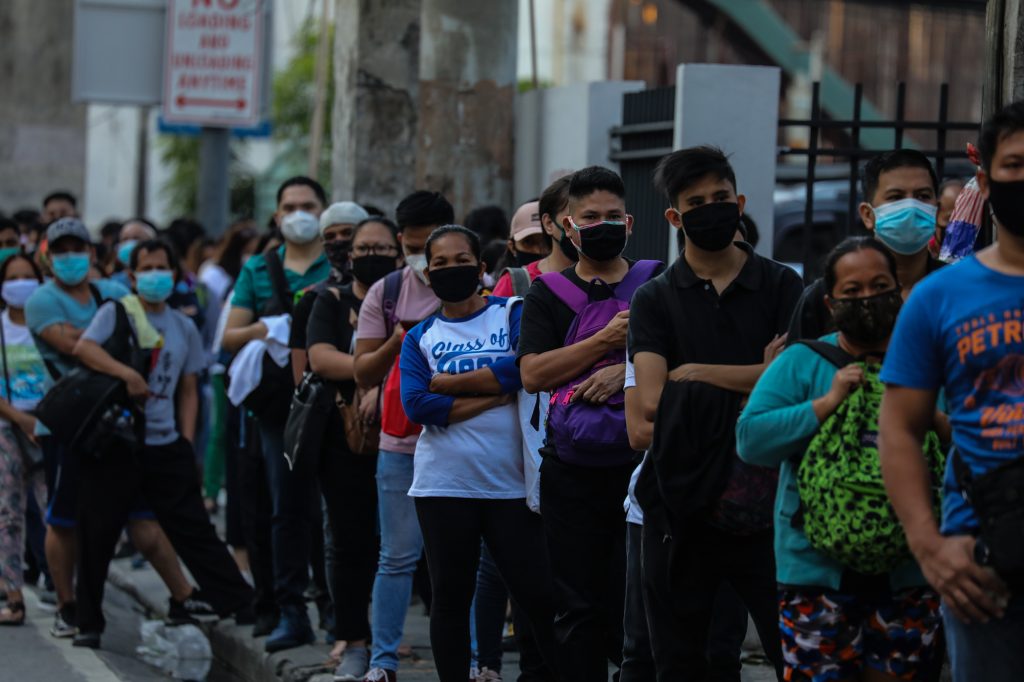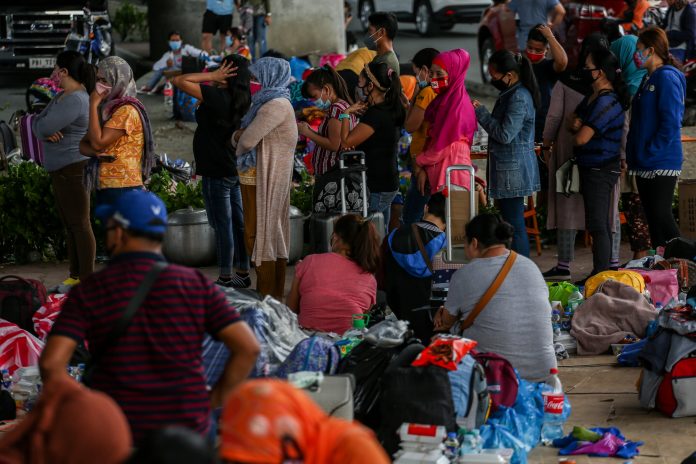They looked like refugees from a war.
Over a hundred people, including children, huddled on the wet streets of a domestic port in the Philippine capital of Manila. Rain fell overnight.
These were passengers of vessels bound for Zamboanga in the southern island of Mindanao and Dumaguete City, in the central Philippines.
Many were Filipinos returning from foreign jobs that had disappeared under the global economic onslaught of the coronavirus pandemic.
Some were locals, newly unemployed, accepting the government’s “back to the province” program that promised new work and more healthy conditions for their families.
They had tickets. They had complied with a list of requirements, including health clearances from communities. They had paid for “rapid tests.” Not a good gauge of anything, according to medical experts, but that was what government wanted.
At least, until they arrived at the port.
There, they were told no one could leave without “swab tests,” formally called the polymerase chain reaction tests. Those tests are the gold standard, but cost ten times as much as rapid tests.
These were people who had lost their jobs. Nobody fed them. Many had to beg dinky establishments nearby for the use of bathrooms; others just did what had to be done in any available corner.
‘Best and brightest’
As the images spread through social media, there was silence from the aging generals who make up President Rodrigo Duterte’s core of “experts.”
Only when posts hit viral levels did Duterte’s best and brightest speak up. And when they did, the generals contradicted each other.
They could leave, said Interior Secretary Eduardo Ano, who oversees local governments across the country. They will undergo swab tests once they reach destination ports.
But Defense Secretary Delfin Lorenza said he was suspending repatriation for two more weeks.
One more day, the workers waited. Nobody could point them to where they could seek shelter or food.
This was not the first incident. Thousands of Filipino overseas workers, many returning as displaced labor in their host countries, had slept for days under the main international airport flyover and street islands around a satellite airport two hours north of the capital in early June.
Dubbed “modern day heroes” because they contribute as much as 10 percent to the country’s gross domestic product, the sector represents a key pillar of support for Duterte.
The coronavirus pandemic showed how they’re at the tail-end of government priorities.
Seafarers, already traumatized as cruise industry workplaces turned into floating coffins, found themselves moored for as long as a month in Manila Bay because of delays in testing.
Ten million Filipinos pay the government every time they leave. And yet the Overseas Workers Welfare Administration thrust many land-based returning workers into unsanitary, unhealthy quarantine centers – if local governments even allowed them in.
Many times they didn’t, because the agency did not bother to inform destination communities.
On the surface, it looked like bigotry and discrimination. But there were few test kits, poor hospital capacity, and little money for quarantine centers in the hometowns and provinces they had left to escape poverty.

Chaos
Ano and Lorenzana are members of the national anti-COVID-19 task force, the implementing arm of the interagency-task force that crafts policies to manage problems with infectious diseases.
Ano, who also oversees the Philippine National Police, also sits on the second body.
Duterte said generals with experience in enforcing order, discipline, efficiency should lead COVID-19 containment programs.
Another general heads the social welfare agency and made a mess of the cash aid program for 18 million poor households.
The government’s three-month lockdown – the world’s longest – was full of jaw-dropping incidents of chaos and brutality. Two men killed at checkpoints; the mentally ill battered amid pleas from neighbors. Police arrested more than 30,000 – mainly from poor communities. Many landed in jails so overcrowded they’re practically incubators for viruses.
Meanwhile, the police chief of Metro Manila partied when it was banned, toasted subordinates with alcohol, also banned; roamed unmasked, and clasped the hands of staff gathered eight or ten to a table or lined up at buffet tables — one of the top ways infection spreads.
Duterte in June eased quarantine protocols in the capital region, claiming COVID-19 was under control.
He allowed businesses to start re-opening but under stringent conditions that limit operations to only 30 percent capacity. That meant layoffs or forced underemployment for workers, most taking pay cuts and rotating work schedules.
Government critics say the move was more an attempt to skirt giving more social aid than the result of a safer health environment.
Confirmed COVID-19 cases neared 37,000 on June 30, with a validation backlog on nearly 11,000 positive cases. Fresh cases continue to rise by the hundreds daily.

On their own
The independent economic think tank Ibon, said nine million of the 18 million poor households promised two cash aid tranches would only get one, or just US$1 a day over 106 days of lockdown.
They are no longer eligible for the second aid tranche. Nobody knows where Duterte will spend the balance of tens of millions of dollars.
In re-opening the economy, however, the government forgot to provide affordable public transport for workers.
The ban on the return of jeepneys meant 78,000 families suffered another month of hunger without reprieve. Workers and micro-entrepreneurs also had to shell out more for transport costs and wait for the limited services available.
The government also refused to spend for testing of the returning workers, forcing more burdens on companies on the brink of collapse.
Duterte and Ano blame citizens for the continued rise in COVID-19 cases. But millions of families left by the wayside know it is the government that is the biggest threat to their safety and security.
Inday Espina-Varona is an award-winning journalist in the Philippines. She is a recipient of the “Prize for Independence” of the Reporters Without Borders in 2018.
The views expressed in this article are the opinions of the author and do not necessarily reflect the editorial stance of LiCAS.news.









